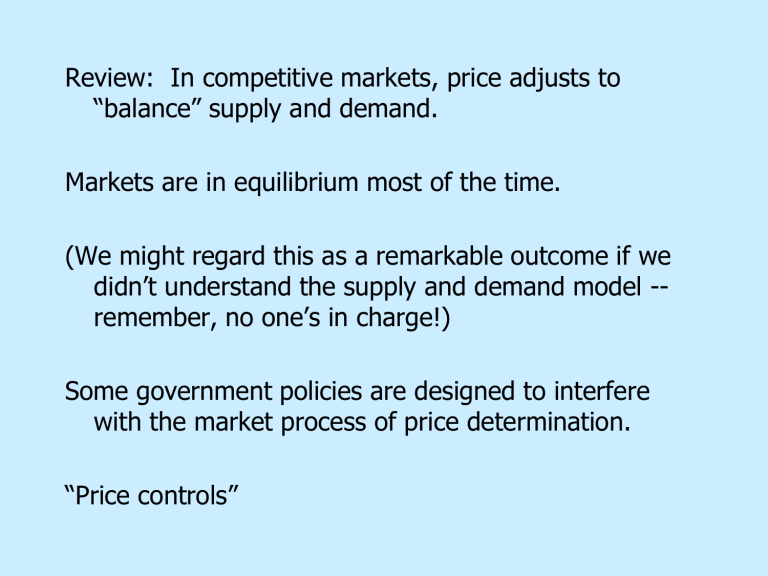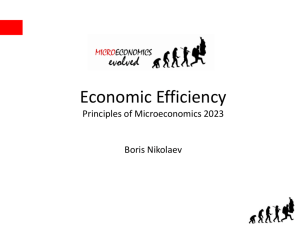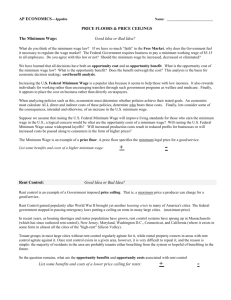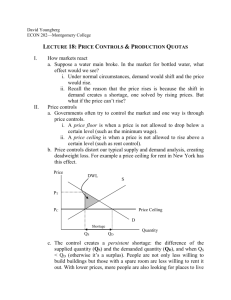minimum

Review: In competitive markets, price adjusts to
“balance” supply and demand.
Markets are in equilibrium most of the time.
(We might regard this as a remarkable outcome if we didn’t understand the supply and demand model -remember, no one’s in charge!)
Some government policies are designed to interfere with the market process of price determination.
“Price controls”
Price ceiling: A legal good can be sold.
maximum
on the price at which a
Price floor: A legal
minimum
good can be sold.
on the price at which a
Economists almost always oppose price controls:
They’re well-intentioned, but . . .
. . . they rarely help
all
who are supposed to benefit,
. . . and they often have unintended
bad
effects.
With a price ceiling, there are two possibilities: price p c1 p*
S
The price ceiling could be at or above p*. p* is a legal price and we would have equilibrium. (“Non-binding” price ceiling.) p c2
Q
S excess demand
Q
D
D
The price ceiling could be below p*. p* is illegal.
(“Binding” price ceiling.)
Price is p c2 and we have excess demand (“shortage”).
quantity
Price ceilings are intended to help buyers.
With a (binding) price ceiling, only some who want to buy at the ceiling price are able to buy.
Shortage creates problems:
Disappointed demanders have incentive to offer an illegally high price . . .
. . . so price ceilings are inherently hard to enforce.
Even if price ceiling can be
strictly
enforced, a “nonprice rationing mechanism” is needed.
Usually, price “rations” the available supply. Those willing to pay p* (or more) get to buy, others do not.
With a binding price ceiling, the usual price rationing mechanism is not allowed to work.
Non-price rationing mechanisms?
-- those willing to wait in line the longest get to buy.
-- only “friends” of suppliers get to buy.
Rent control: A binding price ceiling on the rental housing market.
($/ft.
2 / month)
S
SR p*
S
LR
Probably best to think of “quantity” as total square footage -- rather than number of apartments.
D
1
Q* (ft 2 /month)
Short-run supply
perfectly
inelastic?
In the (sufficiently) short run, number of aprtmts is fixed.
Rent control is often imposed in response to a big influx of population - increasing demand for rental housing.
Effects of such a demand shift - WITHOUT rent control:
($/ft.
2 / month) p** p*** p*
S
SR
In short-run:
Rent jumps to p**.
No quantity effect.
S
LR
D
1
D
2
Q* (ft 2 /month)
Q***
In long-run:
Rent comes down
(part-way) to p***.
Quantity increases to Q***.
Now consider the effects of the demand shift WITH rent control imposed at level of original equilibrium, p*:
($/ft.
2 / month)
S
SR excess demand
S
LR
In the short-run:
No increase in rent, but excess demand . . .
p*
D
2
D
1
. . . that persists throughout long-run.
Q* (ft 2 /month)
Rent control “cancels” the price signal that otherwise would have increased quantity of rental housing.
Rent control does deprive landlords of the short-run
“windfall” they otherwise get from increased demand.
Does it benefit tenants?
Some benefit -- those with rent-controlled apartments who are happy where they are.
Some lose -- those who make up “excess demand.”
Again: Excess demand isn’t relieved in long-run because rent control “cancels” the price signal.
(More on rent control: http://www.econlib.org/ . . .
)
Now price floors. As with price ceilings, there are two possibilities: price p f2
S
The price floor could be above p*. p* is illegal.
(“Binding” price floor.)
Price is p f2 and we have excess supply (“surplus”).
p* p f1 excess supply
Q
D
Q
S
D
The price floor could be at or below p*. p* is a legal price and we would have equilibrium. (“Non-binding” price floor.) quantity
The point of price floors is to benefit suppliers.
To accomplish this, government has to purchase surplus.
Agricultural commodity price support programs . . .
. . . for corn, for example.
What can the government do with the surplus?
Sell it?
Give it away?
Build more government corn bins!
Minimum wage: A price floor on the labor market.
Current federal minimum wage = $7.25/hr.
(as of 07/24/09)
Current Iowa minimum wage = $7.25/hr.
Current Illinois minimum wage = $8.25/hr.
Currently the highest state minimum wage = $8.67/hr.
(Washington)
(In San Francisco, minimum wage = $9.92/hr.)
(source: http://www.dol.gov/esa/minwage/america.htm#content )
Consider Iowa minimum wage of $7.25/hr.
In terms of annual income (assuming a work year of 50 weeks x 40 hrs./wk. = 2000 hrs.):
$7.25/hr x 2000 hrs./yr. = $14,500/yr.
U.S. Health and Human Services 2010 Poverty
Guideline:
Family of 4 = $22,050/yr.
( http://aspe.hhs.gov/poverty/10poverty.shtml
)
Market for (“low-skill”) labor: wage
($/hr.) w min w*
S
Note: In labor markets, firms are
“demanders,” households are
“suppliers.” surplus
D
L
D
L
S quantity of labor
(hrs.)
In this case, surplus = “unemployment” -- people who want to work at w min but cannot.
It’s supposed to benefit low-skill workers. Does it?
Some benefit -- those who keep their jobs when minimum wage goes into effect.
Some lose -- those who are displaced. (Employment falls (!) when law raises wage from w* to w min
.)
Are the benefits well-targeted? (Does it help mainly
“bread-winners” in low income households -- or mainly middle-class teenagers?)
(More on minimum wage: http://en.wikipedia.org . . .
)
How big is the “displaced worker” effect?
One recent study . . .
( http://www.theworkbuzz.com . . .
)
. . . says it’s “small.”
Economists are still somewhat divided on the minimum wage.











